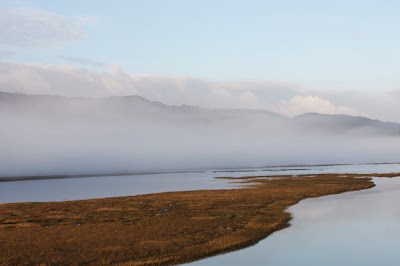I spend a lot of my time photographing on the water and near the water. As such there have been a few things I’ve had to learn- water reflects light, water is bad for your camera, your feet get wet if you only watch your subject (and not where you are going,) and that the shore is not the same thing as the horizon.
What does this mean? Have a look at the two images on the right. Notice the top one looks skewed compared to the bottom one.
Which of these two images is level? Which version is more pleasing to look at?
The top picture was taken using a tripod with a built in level in its head. The appearance of the shore/horizon being out of level is an illusion of distance. On the right hand side of the photograph, the land is much farther away, a mile or so. Being level however, it just feels funny.
For the lower image I used the straighten tool on my computer’s photo viewing software, lining up the horizon with the grid lines. It feels more natural in the composition. There is no strong foreground element that declares where level is, so I am able to “create” a new level that makes sense to the eyes. In this case, out of level can look more natural.
A way to “straighten” an image without post processing is to use your cameras focusing grid. I sometimes do this when I am out shooting. I place two of my focal points that are in line with each other on the horizon, and “preset” the lean. Sometimes, if I don’t notice something in the foreground, or if there is a nearby tree, this can work against me. Buildings or trees can acquire a “lean” if I “level” the photo out.

A strong foreground element can help establish a level feel for an image, especially if it is in a contrast area
It isn’t always necessary to combat or worry about the far horizon. If you can include subjects in the foreground that immediately draw the eye, they can pre-establish where level is. Look at the picture on the right. The silhouette of the rotting boat cradle on the waters edge is one of the strongest elements and has good contrast. The eye goes there first. Level is immediately established by the reflection and how the water hits the cradle. The slight angle of the far shore becomes irrelevant and natural.

Including shoreline that leads through the picture helps establish that the shoreline is not supposed to be level
Another way is to show the shoreline as it winds away almost from your feet. This establishes right away that the shoreline will not be a horizontal line by the time it is more distant. Notice in this picture how the very far shorelines that jut out into the picture seem to rise slightly to the right? Again, an illusion, but one that is allowed by the foreground.
A third method is to include the near shore as well as the farther shore. Also, try shooting straight across a body of water, instead of up or down it. Shoot from angles where there is no major change in distance between the left side of the frame and the right.
Sweeping curves, lines from the edges, joining the shore at points where the mind can easily realize that the shore is not supposed to appear level are all good ways to watch your horizon. There are more ways, so take your camera and find some of them. Play with objects that the mind should think of as level or plumb, and see how incorporating them into your images affects your horizon.
Many of these same tricks and effects can also be noticed with fields, some skylines, and other open spaces. Play around, enjoy. Try to take notes of which pictures you take level, and which ones are offset so that you can understand what leads to acceptable results, and what keeps you scrathcing your head trying to figure out what is wrong.






